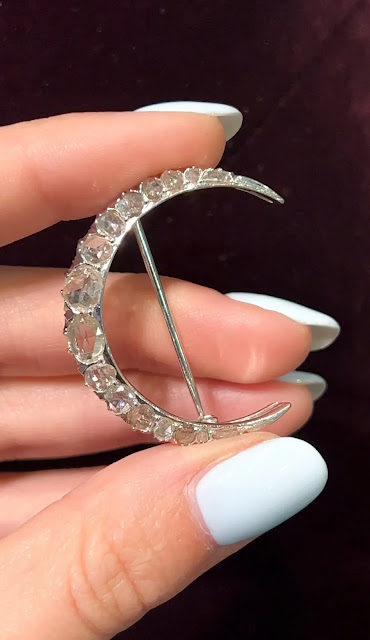The Waxing / Waning Moon
Throughout time, the human timeline has been measured by the heavens. Across the globe from the beginning of time, man (and woman) has used the celestial heavens to track time as well as navigation. The celestial symbology seen throughout the shared human existence dates back eons. In today's post, I'd like to discuss one particular member of that mythology - the moon - more specifically the waxing / waning moon, better known as the crescent moon.
The crescent moon has been associated with goddesses in many ancient traditions as a symbol of fertility. For example, in Ancient Egypt, Isis represented both the female creator god as well as motherhood. Similarly, Hathor was associated with maternal love and nurturing. The importance of these two deities then influenced Greek mythology. That influence can been seen in the goddess Artemis otherwise known as “the lady of wild things.” Artemis was one form of the moon goddess Selene. Her name was likely derived from "selas" the Greek word for “light.” It was said that she drove a chariot of white horses across the sky at night thereby providing the evening light. Women wishing to conceive would pray to the moon goddess for assistance in bringing new life into the world.
 |
| I adore this chunky rose cut diamond crescent moon brooch available through LoSmeraldo, circa 1830s. |
In Roman mythology the crescent shape symbolized the bow used by Diana, goddess of the hunt. In Chinese philosophy the moon is the yin to the sun’s yang thereby demonstrating how the female moon and male sun can perfectly balance as opposites. In Celtic tradition, the moon goddess Brigid was said to cure diseases using herbs, cementing her right a deity of protection, healing, poetry and wisdom.
As a result of these mythological associations, the crescent moon has long been considered a symbol of protection, transition and new beginnings. While the stars were symbols of direction and guidance for the spirit; the crescent moon was used to represent change as demonstrated by its multiple lunar phases. Its waxing and waning cycle, which represents both the time before something new begins (waxing) and after it ends (waning), can also be seen as representing one's life journey from darkness into light - the birth to death process. It offers guidance and also reminds us there’s always hope, that the sun will come out tomorrow on a new day. A new chance at life.
 |
| This 15kt Victorian shamrock crescent brooch from the Springer Boutique is a perfect example of the luck & motivation to achieve your dreams during the waxing moon. |
The symbol of the crescent moon in jewelry design also represents both the waning moon and waxing moon phases. The waxing phase is when the amount of the lit surface is increasing, going toward a full moon. As the moon grows in illumination, the belief is that it brings with it a new lease of energy and positivity thereby providing us with the motivation to achieve our dreams. The waning moon phase (when the moon is moving towards a new moon) encourages us to focus on removing the negative energy from our lives as the moon appears to get smaller.
The crescent moon was incredibly popular during the Georgian, Victorian and Edwardian eras. Antique jewelry from these periods were saturated with secret messages, symbolism and sentiment. The crescent moon appears on talismans and jewelry from some of the oldest of archaeological finds. In vintage jewelry, we see it most often in Victorian and Art Nouveau era pieces. The Victorians perfected the art form of symbolism in jewelry. The Victorians famously used motifs such as flowers and gems as a way of discretely communicating elaborate messages. Victorian brides often associated crescent moons cradling flowers as romantic, and this image was often depicted on their “honeymoon brooches." Crescent moons paired with stars were often thought of in terms of as a romantic soulmate reference. Crescent moons in Victorian jewelry often represented spirituality and the glorification of the feminine moon goddess.
 |
| One of my dream pieces available from Jeremy Silverthorne, is this 15kt Victorian gold ruby, sapphire & diamond crescent brooch, circa 1890s. |
During the Art Nouveau period, the designs of the 1910’s were heavily influenced by mythology. The Roman goddess Diana was a favorite subject. Like her Greek counterpart, Artemis, Diana was the goddess of the hunt. Diana is often represented with a crescent moon crown on her head. Jewelers and artisans sometimes crafted crescent moon brooches that were longer and slimmer than the standard, as though they were ready to be strung and used by the goddess herself on a hunt!
The moon in any form is considered to be feminine, an empowering symbol that represents female influence, intuition and kindness as well as the power women wield throughout the world. The moon influences us in many ways, from the tides it creates to the emotions we feel. A full moon is thought to boost creativity, energy levels and positivity.
 |
| Wouldn't you just love to wear this 3.41ct diamond crescent brooch from AC Silver Antiques on a chain as well?! |
Crescent moons have been worn by lovers for centuries as a symbol of love and fertility. Unmarried women in some cultures wear them believing it will bring them their soulmate where as married couples use them to represent a lasting relationship. Crescent moons are also worn to bring luck and wealth as well as provide protection against negativity.
Be sure and follow Inspired Antiquity on Instagram: InspiredAntiquity, Twitter: @NpiredAntiquity, Pinterest: www.pinterest.com/tkmb & Facebook: https://www.facebook.com/InspiredAntiquity .


Comments
Post a Comment